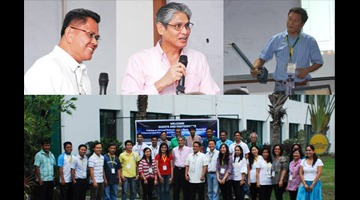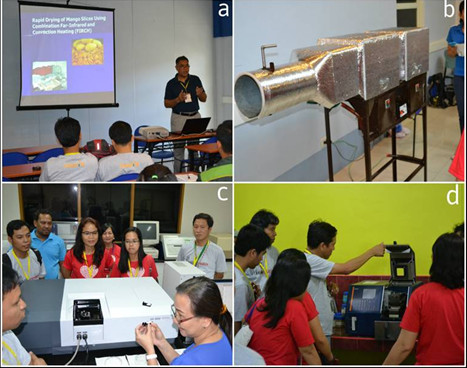 Researcher-scientists from selected universities and research institutes were trained recently on the principles and use of infrared spectroscopy.
Researcher-scientists from selected universities and research institutes were trained recently on the principles and use of infrared spectroscopy.
Held at PhilRice, Maligaya, Muñoz, Nueva Ecija, the training was conducted by PCAARRD and PhilRice because of the technologies’ potential application to agriculture and food industries.
The training, which was funded by the Bases Conversion and Development Authority (BCDA) through the Department of Science and Technology (DOST), was titled “Infrared Technologies for Grain Quality Assessment and Post Harvest Processing of Rice and Other Important Commodities.“
Infrared spectroscopy technology in particular, can be used as analytical tool to determine the products’ composition and quality for global markets.
The five-day training course consisted of lecture-demonstrations on infrared technologies; NIR spectroscopy for grain quality development; Infrared drying and storage instrumentation for grains; and Combination of far infrared and convection drying application.
In simple terms, Infrared (IR) energy is light that is not visible, but bodies can detect it as heat. It is a part in the electromagnetic spectrum at wavelengths longer than the visible lights. The infrared portion in the spectrum is usually divided into near-, mid-, and far-infrared. Near Infrared (NIR) has the highest energy with wavelength of 0.8 to 2.5 micrometers.
 Among the Infrared technologies, the NIR spectroscopy is widely applied in agriculture. It is a fast, safe, and reliable technology that analyzes the quality of forages, grains, and grain products, coffee, tea, spices, fruits, vegetables, sugarcane, dairy products, eggs, meat, and other agricultural products. It is widely used to determine and quantify the composition of agricultural products. It is non-destructive, requires simple preparation, accurate, and inexpensive in the long run.
Among the Infrared technologies, the NIR spectroscopy is widely applied in agriculture. It is a fast, safe, and reliable technology that analyzes the quality of forages, grains, and grain products, coffee, tea, spices, fruits, vegetables, sugarcane, dairy products, eggs, meat, and other agricultural products. It is widely used to determine and quantify the composition of agricultural products. It is non-destructive, requires simple preparation, accurate, and inexpensive in the long run.
Dr. Jasper Tallada, PhilRice’ Senior Research Fellow, said that that the Philippines is way behind in using NIR spectroscopy technology for both agricultural and industrial applications.
Since NIR spectroscopy instruments are mostly imported and too expensive for small and medium-scale companies, PCAARRD has funded the development of locally-produced NIR spectroscopy instrument for smart farming support services on food and feed quality and safety.
Led by Dr. Beng P. Umali of Cavite State University, the project is expected to benefit feed milling laboratories, universities and research institutes, and other companies that need fast, reliable, and accurate measurement of product quality.
The training course provided participants with the knowledge on the importance of infrared technologies in improving grain quality and post harvest efficiency. It yielded action plans on the applications of the training course to ongoing programs and projects of participating agencies.
These agencies include the Benguet State University, Bohol Island State University, Cavite State University, Central Luzon State University, Department of Agriculture-Region II; Philippine Center for Postharvest Development and Mechanization, Philippine Rice Research Institute, and University of the Philippines Los Banos’ College of Engineering and Agro Industrial Technology and Institute of Plant Breeding.
